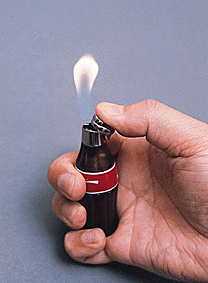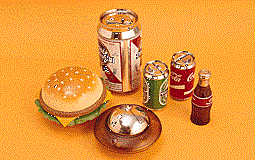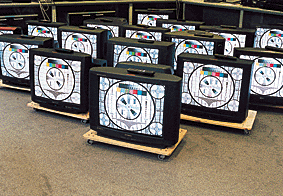The Consumer Council today issued a warning on novelty cigarette lighters that pose a grave injury and fire risk to children.
Over the past 2 years, at least 6 fire accidents were reported to have been related to children playing with cigarette lighters. These accidents resulted in the death of one 2-year-old child.
It cannot be ascertained what type of cigarette lighter was involved in these accidents.
But there is now a growing proliferation of novelty cigarette lighters that are no doubt a great draw to the curiosity of children.
These gadgets come in various designs, shapes and sizes - that have the appeals of a toy, although they should not be construed as a toy, than a conventional cigarette lighter.
They depict or resemble imaginatively cartoon characters, guns, cellular phones, watches, musical instruments, cars, animals, food and beverages…… Some novelty lighters even play musical tunes or have flashing lights.
Children playing with novelty lighters can accidentally push the ignition button with potential grave consequences of injury or even fire accidents.
The attention of the Council was drawn to these products following a consumer complaint of the hazards of these lighters. As a matter of urgency, the Council swiftly conducted an inspection, instead of a full-scale test, of 43samples of disposable and novelty lighters from the market.
The inspection found only 1 sample designed with a child resistant mechanism. However, the mechanism, an on-off locking device, cannot reset itself automatically after each operation, which means that it is effectively without a child resistant design.
Other design problems observed on these sample that have one or more of these hazards include :
- the ignition buttons were not prominent, e.g. hidden in the wheel of toy cars, the antenna of toy cellular phones, or on the arm of toy animals, thus the user might unintentionally ignite the lighter;
- flame blew in the direction of the user's face;
- the ignition button was too near to the flame;
- excess flame height;
- most adjustable lighters did not have the flame height adjustment indicator required to produce a higher or lower flame. Without the indicator, the user might adjust the flame height wrongly. An unexpectingly high flame might shock or even burn the user.


In addition, out of the 43 samples, 38 did not come with the appropriate warnings: "keep away from children; ignite lighter away from face and clothing; be sure flame is out after use; contains flammable gas under pressure;never expose to heat above 50℃; never expose to prolonged sunlight; never puncture or put in fire".
Manufacturers, importers and suppliers of cigarette lighters are strongly urged to display the appropriate warnings and also to introduce child-resistant cigarette lighters to the local market.
Parents, on the other hand, are advised to keep those lighters out of reach of children and warn them of the hazards.
And there is more to keeping your kids from burning.
Parents, garment manufacturers and sellers are alerted to the risks of fire from some fabrics used for children's wear.
The alert followed a recent Consumer Council test to assess the flammability of children's garments available on the market. It focused on 43samples of children's top (24), pants (6), top and pants (10) and baby wrapping blankets (3).
The test was performed in accordance with the US standard for flammability - 16 Code of Federal Regulations Part 1610 under the Flammable Fabrics Act.
The same standard is adopted by the US Consumer Product Safety Commission which has announced product recalls of garments that failed to be in compliance with the standard.
Under the US standard, the flammability of fabrics used in garments is classified into three classes :
- Class 1 - normal flammability
- Class 2 - intermediate flammability
- Class 3 - rapid and intense burning
Of the 43 test samples, 7 were found to be in Class 3. This means that the time of flame spread of the fabrics is less than 4 seconds when subjected to the test condition.
All 7 samples in question were made of 100% cotton fleece fabric and found to be dangerously flammable in their original state (prior to being subjected to a process of dry cleaning and washing as required by the US standard).
It should be stressed that regardless of their flammability classification, most fabrics when subjected to fire are combustible, and that normal flammability does not mean "flame proof". It simply means that they ignite less easily and burn more slowly than other more flammable fabrics.
It would not be advisable to wear apparel of highly flammable fabric to such activities as barbecue, Chinese hot pot or camp fire.
The design of children's wear may also help minimise the risks. Close-fitting rather than loose-fitting styles are preferable because there is less air underneath and less likely to brush against heaters, fires or stove tops.
As a general fire precaution, parents must not leave their children alone or unattended at home and must strictly warn children against ignition sources such as fires, heaters, stoves and matches. Older people may be at risk,too, not just children.
Details of the test were released today in the latest (255) issue of the Council's monthly magazine 'CHOICE'.
The report emphasised that the objective of the testis to draw the attention of and alert manufacturers, agents, retailers and the consumer public to the potential hazard of flammable fabric in children's wear.
There is no need for undue worry over flammable fabrics. The findings are applicable to only the samples included in this test and do not reflect, in any way, the quality of all other products of the same brands concerned.
At least one retailer has responded positively and has removed from the shop shelves the garments in question. The retailer also undertakes not to sell garments of the same fabric. The Council considers this to be a responsible behavior of the retailer.
The general safety requirements of the Consumer Goods Safety Ordinance can be applied to ensure the safety of fabrics used in clothing textiles or items of wearing apparel.
Although fibre content and care labelling on fabrics are not legally required in Hong Kong, manufacturers and suppliers are urged to provide their products with such essential information and the appropriate warning and advice on the potential hazard of flammability.
Have you ever paused to think how much time a day you - or your family - spend in front of a television set?

Choosing a TV set to your complete satisfaction, therefore, rightly deserves some of your time and energy.
And buying guide is on its way from the Consumer Council - if you happen to favour a 29 inch multi-system Nicam model.
In this 255 issue of 'CHOICE' is published a comparative test report on 16 models from 10 brands with list prices ranging from a modest$3,700 to $17,000.
Significantly, the test compared the performance of the models in details. This covers picture and sound quality, ease of use, power consumption and electrical safety.
The results are revealing: some samples performed well on both picture and sound, and some were less satisfactory on both aspects.
The test found no direct correlation between price and quality although the models at the higher price end fared, on the whole, better.
The resolutions of some samples are lower than 400lines. So when playing back high quality images such as those from laser discs, users may not get the highest clarity.
It is also found that some samples unnecessarily consumed more electricity than others in the standby mode. They waste energy and are not environmental friendly.




